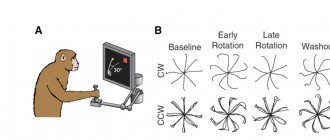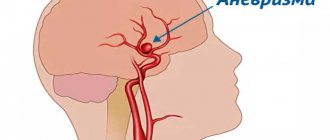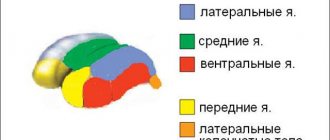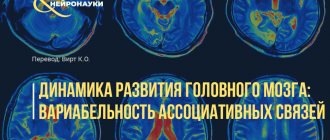The auditory cortex selectively hears what we listen to
Rice. 1.
Areas of the superior temporal gyrus responsible for the perception of spoken language.
primary auditory
cortex receives information from the thalamus, where it arrives (through several intermediate stages) from the organ of hearing - the cochlea.
This information is structured from the very beginning - divided into frequencies. auditory cortex
takes the first steps toward understanding what is heard by filtering auditory information and combining it with data from other senses.
Wernicke 's area
, which occupies the most posterior part of the superior temporal gyrus, recognizes words and plays a key role in speech understanding. Image from D. Purves, G. J. Augustine, D. Fitzpatrick, et al. editors. Neuroscience. 2nd edition. Sunderland (MA): Sinauer Associates; 2001
People are able to listen and understand each other even in a company where everyone is talking at the same time. How the brain selects the necessary sounds from a complex acoustic background is unknown. American neuroscientists, working with patients who had electrodes implanted into the superior temporal gyrus during treatment for epilepsy, discovered that the activity of neurons in the secondary auditory cortex reflects the speech of the person to whom the subject is listening. Based on the activity of these neurons, a specially trained computer program can determine which of the two speakers the subject is listening to and reconstruct the words heard.
Isolating the speech of one specific person from a multi-voice choir is a technically extremely difficult task, as developers of automatic speech recognition systems are well aware of. Our brain, however, easily copes with it, but how it does it is not really known. It can be assumed that at some stage in the processing of auditory information, the speech of the person we are listening to is cleared of “extraneous impurities,” but when and where this happens is again unclear.
Nima Mesgarani and Edward Chang from the University of California, San Francisco, studied the functioning of neurons in the secondary auditory cortex (Fig. 1) in three patients with epilepsy who, in preparation for surgery, had microelectrodes implanted in the superior temporal lobe. gyrus (Fig. 2).
Rice. 2.
Location of electrodes on the subjects' brains.
Shades of red
show how different the signal from the electrode is when perceiving speech and in silence.
Image from the discussed article in Nature
Previously it was shown that neurons in the secondary auditory cortex “encode” (reflect) the spoken language perceived by a person. Computer programs have been developed that, after special training, are able, based on data on the activity of these neurons, to reconstruct the timbre of the speaker’s voice and even recognize spoken words (Formisano et al., 2008. “Who” is saying “what”? Brain-based decoding of human voice and speech Pasley et al., 2012. Reconstructing Speech from Human Auditory Cortex). But these experiments were carried out on subjects who were allowed to listen to the speech of only one speaker. Mesgarani and Chang decided to find out what information the auditory cortex neurons would reflect if there were two speakers, but the subject was asked to listen to only one of them.
The experiments used recordings of two voices - male and female. They uttered meaningless seven-word phrases such as “ready tiger go to red two now” or “ready ringo go to green five now.” The first, third, fourth and seventh words were always the same. The second word - tiger or ringo - served as a conditioned signal for the subject. One of these words was displayed on the screen in front of him, and he had to listen to which of the two speakers would pronounce this word. In fifth place was a word denoting one of three colors (red, blue or green), in sixth place was one of three numerals (two, five or seven). The subject had to answer what number and what color was named by the one of the two speakers who uttered the key word. The phrases were combined in such a way that two voices simultaneously called different numbers and colors.
The authors used a previously developed program to reconstruct the sound signal from data on the activity of neurons in the auditory cortex. The program was previously “trained”, and during the training the subjects were allowed to listen to voices one at a time, and not both at the same time. When the program learned to reconstruct spectrograms of single phrases well, the main phase of the experiment began. Now the subjects listened to two voices simultaneously, and the spectrograms reconstructed by the program from data on neuronal activity were compared with real spectrograms of phrases spoken by two speakers.
It turned out that in those cases when the subject successfully completed the task (that is, correctly named the color and number pronounced in the voice that said the key word), the spectrogram reconstructed from his neurons reflected the speech of only one of the two speakers - the one who was needed listen (Fig. 3). If the subject was mistaken, the reconstructed spectrogram was not similar to the speech of the “correct” speaker, but reflected either an unintelligible mixture or correlated with the spectrogram of the second, “distracting” speaker. As a rule, in the first case the subject could not correctly reproduce the words of either of the two speakers, and in the second he indicated the number and color, called the “distractor” voice.
Rice. 3.
Examples of oscillograms and spectrograms of spoken phrases (
a
–
d
) and reconstructions of spectrograms made by a computer program based on data on the operation of neurons in the auditory cortex (
e
–
h
).
a
,
b
- phrases spoken by two voices -
SP1
(male) and
SP2
(female) - separately.
c
,
d
- phrases spoken by two voices simultaneously (in figure
d, blue
and
red colors
show the areas in which the voice of the first or second speaker is louder, respectively).
e
,
f -
spectrograms reconstructed by a computer program based on the work of neurons in the auditory cortex when listening to two phrases one by one.
g
,
h
- the same, when listening to both phrases simultaneously (
g
- the subject listens to the first voice,
h
- to the second).
Image from the discussed article in Nature
At the final stage, the authors used a computer program - a regularized linear classifier (see Linear classifier), trained to distinguish between two voices and spoken words based on the activity of neurons in the auditory cortex when listening to single phrases. When this program was asked to process data on the work of the same neurons when listening to two voices at the same time, it successfully identified both the voice (male or female) and the words (color and number) spoken by the speaker to whom the subject was listening. In those experiments in which the subject completed the task, based on the work of his neurons, the program successfully identified the voice in 93%, the color in 77.2%, and the number in 80.2% of cases. In experiments where the subject made a mistake, the program either produced a random result or recognized the “distracting” voice and the words spoken by it.
Thus, the study showed that in the secondary auditory cortex, speech information is reflected in a “filtered” form: the work of neurons encodes the speech of the person to whom the subject is listening. Although we still do not know the mechanisms of this filtering, it is already possible to determine from the activity of neurons in the auditory cortex which of the two speakers a person is listening to and identify the words heard.
Source:
Nima Mesgarani, Edward F. Chang.
Selective cortical representation of attended speaker in multi-talker speech perception // Nature
. 2012. V. 485. P. 233–236.
See also:
Hearing is responsible for the integration of hearing and touch, “Elements”, 10.24.2005.
Alexander Markov
Sensory areas of the cerebral cortex
The cerebral cortex receives afferent impulses from all receptors in the body. The direct transmitting station of these impulses to the cortex (with the exception of impulses coming from the olfactory receptors) are the nuclei of the thalamus and the formation adjacent to it, where the third neurons of the afferent pathways are located (p. 542). I. P. Pavlov called the areas of the cortex into which afferent impulses predominantly arrive the central sections of the analyzers.
| The central sections, otherwise known as the cortical representation, of many analyzers, for example cutaneous, joint-muscular (kinesthetic), visceral, spatially coincide and partially overlap each other. The areas of the cortex in which the central sections of the analyzers are located are usually called sensory areas of the cerebral cortex (Fig. 246). Sensory areas of the cerebral cortex represent a cortical projection of peripheral receptor fields. Rice. 246. Localization of some sensory and motor areas in the cerebral cortex in humans (schematized). |
Representation of somatic and visceral sensitivity. In each hemisphere there are two zones representing somatic (cutaneous and joint-muscular) and visceral sensitivity, which are conventionally called the I and II somatosensory zones of the cortex. The first somatosensory cortex is located in the posterior central gyrus.
| Its size is much larger than the second one. This zone receives afferent impulses from the posterior ventral nucleus of the thalamus, delivering information received by cutaneous (tactile and temperature joint-muscular and visceral receptors on the opposite side of the body. In Fig. 247 shows the location of projections of various parts of the human body in this zone. As you can see, the largest area is occupied by the cortical representation of the receptors of the hand, vocal apparatus and face, the smallest area is occupied by the representation of the trunk, thigh and lower leg. Rice. 247. Location of projections of various parts of the body in the somatosensory zone of the human cerebral cortex (according to W. Penfield and Rasmussen). 1 - genitals; 2 - fingers; 3 - foot; 4 - lower leg; 7 - neck; 8 - head; 9 - shoulder; 10 - elbow joint; 11 - elbow; 12 - forearm; 13 - 15 - little finger; 17 - middle finger; 18 - index finger; 19 — thumb; 21 - nose; 22 - face; 24 - teeth; 25 - lower lip; 26 - teeth, gums and jaw; 27 - tongue; 28 - pharynx; 29 - internal organs. The sizes of body parts correspond to the sizes of sensory representation |
The area of the cortical projection is determined by the number of nerve cells of the cortex involved in the perception of stimulation from a particular receptor field. The greater the number of cells, the more differentiated the analysis of peripheral irritations. Cortical projections of receptors of visceral afferent systems (digestive tract, excretory apparatus, cardiovascular system) are located in the area where skin receptors are represented in the corresponding areas of the body.
The second somatosensory zone is located under the Rolandic fissure and extends to the upper edge of the Sylvian fissure; afferent impulses to this zone also come from the posterior ventral nucleus of the thalamus.
Representation of visual reception. The cortical ends of the visual analyzer, the so-called visual zones, are located on the inner surface of the occipital lobes of both hemispheres in the area of the calcarine sulcus and adjacent gyri. The visual zones are a projection of the retina. Afferent impulses enter this area from the external geniculate bodies, where the third neurons of the visual pathway are located.
Representation of auditory reception. The cortical ends of the auditory analyzer are localized in the first temporal and so-called transverse temporal gyri of Heschl. Afferent impulses enter this zone from the cells of the internal geniculate tract) and carry information from the bodies (the third neurons of the auditory mulberry receptors of the cochlea of the inner ear. Impulses arising in the receptors of the cochlea when perceiving tones of different pitches enter various groups of cells in the auditory zone.
Representation of taste perception. The cortical ends of the taste analyzer, according to Penfield, are located in humans in the temporal lobe near the area of the cortex, the irritation of which causes salivation. Afferent impulses enter the taste zone from the inferior posterior nucleus of the thalamus.
Representation of olfactory reception. The olfactory sensory pathways are the only afferent pathways that do not pass through the nuclei of the visual thalamus. Their first neurons - olfactory cells - are located in the nasal mucosa. The second neurons are located in the olfactory bulb. The processes of the second neurons form the olfactory tract, which reaches the cells located in the anterior part of the piriform lobe (L. Brodal), where the cortical end of the olfactory analyzer is located.
Effects of irritation and destruction of sensory areas in humans. The localization of sensory zones in humans has been studied mainly by the method of electrical stimulation of various points of the cortex during brain operations. Since such operations are performed under local anesthesia, the patient can give an accurate verbal description of the sensations he experiences. The latter, as shown by detailed studies conducted by Penfield et al., are always of an elementary nature. Thus, when the visual zone is irritated, a person experiences sensations of flashes of light, darkness and various colors. No complex visual hallucinations are observed when this area is stimulated. Irritation of the auditory cortex causes sensations of various sounds, which can be high and low, loud and quiet; however, the patient never experiences speech sounds with electrical stimulation. Irritation of the somatosensory zone causes sensations of touch, tingling, numbness, and less often a weak temperature or pain sensation. Severe pain is almost never observed. When the olfactory or gustatory zone is irritated, various smell or taste (mostly unpleasant) sensations arise.
Destruction of sensory zones in humans usually leads to gross disturbances of this type of sensitivity on the side of the body opposite to the lesion. Bilateral damage to the visual zones leads to complete blindness, and removal of the auditory zones leads to deafness. Dysfunctions of sensory zones in humans due to hemorrhage, tumor, or injury are compensated much worse than in animals. Based on experiments conducted on dogs with the removal of different areas of the cerebral cortex. I. P. Pavlov came to the conclusion that at the cortical end of each analyzer one should distinguish between the central part, or core, and the so-called scattered elements. By these elements he understood nerve cells located in a wide area, where impulses arrive from the same receptors as in the analyzer core. The presence of scattered elements provides the ability to compensate for the function in the event of destruction of the analyzer core. In humans, compensation of functions is less pronounced, probably because the nerve cells of the cortical ends of the analyzers are more concentrated in the sensory areas.
Alalia is an organic disorder (underdevelopment) of speech of a central nature. With alalia, there is a delay in the maturation of nerve cells in certain areas of the cerebral cortex. Nerve cells stop their development, remaining at a young immature stage - neuroblasts. This underdevelopment of the brain can be congenital or early acquired in the pre-speech period - organic brain damage with alalia occurred in the prenatal or early postnatal period. Conventionally, the pre-speech period is considered to be the first three years of a child’s life, when the cells of the cerebral cortex are intensively formed and when the child’s experience of using speech is still very small. The development of the brain systems most important for speech function does not end in the prenatal period, but continues after the birth of the child.
Underdevelopment of the brain or its early damage leads to a decrease in the excitability of nerve cells and to changes in the mobility of basic nervous processes, which entails a decrease in the performance of cells in the cerebral cortex.
The study of the pathophysiological mechanisms underlying alalia reveals a wide irradiation of the processes of excitation and inhibition, inertia of the main nervous processes, and increased functional exhaustion of cells in the cerebral cortex (I. K. Samoilova, 1952). Researchers note a lack of spatial concentration of excitatory and inhibitory processes in the cerebral cortex. A study of the electrical activity of the brain in children with alalia revealed clear local changes in biopotentials mainly in the temporo-parieto-occipital regions, in the frontotemporal and temporal branches of the dominant hemisphere (L. A. Belogrud, 1971; A. L. Lindenbaum, 1971; E. M. Mastyukova, 1972).Recent studies show that with alalia there are mild but multiple damage to the cerebral cortex of both hemispheres, i.e., bilateral lesions. Apparently, with unilateral brain damage, speech development occurs due to the compensatory capabilities of a healthy, normally developing and functioning hemisphere. With bilateral injuries, compensation becomes impossible or severely difficult. Thus, the previously existing point of view about the narrow local nature of damage to the speech areas of the brain (the cortical end of the speech-auditory and speech-motor analyzers) is not confirmed.” (Volkova L.S.)
Alalia forms.
Alalia motor (expressive). “Alalia is an underdevelopment or gross disturbance of the development of speech in a child, occurring in the pre-speech period, having a systemic nature and caused by pathology of the central nervous system of certain areas of the cerebral cortex….
The fact that alalia is determined by the pathology of the central nervous system in the pre-speech period indicates that alalia is a consequence of some early pathological influences on the child’s brain. The attribution of the pathology primarily to the level of the cortex indicates that the pathological process involves mainly not the elementary, musculomotor or sensory, but the higher parts of the central nervous system, which are closely related to thinking.”
Expressive speech is realized through different levels of the brain. At the gnostic-praxic level, articulatory praxis is carried out: afferent (kinesthetic) is associated with the functioning of the lower parietal (postcentral) zone, efferent (kinetic) articulatory praxis is provided by the premotor cortex of the brain. At the symbolic (linguistic) level, the brain mechanisms of speech are relevant for the phonological (phonemic) system of language, and also for the lexical and syntactic system. Within the framework of the lexical system of language, the main type of speech activity is naming - a function that is carried out primarily by the tertiary (temporo-occipital) zone on the left (according to E.P. Kok).
The brain organization of the syntactic system of language (phrasal speech) has the most complex multi-level structure. At the level of deep (“nuclear”) syntax, the frontal lobes of the brain play a major role. The core syntactic structure of a phrase is, “essentially”, its extremely compressed program.
It is distinguished by a high degree of logic and, therefore, is close to mental activity as a whole. The surface syntactic structure of a phrase is a “reversal” of its nuclear part. It is carried out mainly due to the posterior frontal parts of the left hemisphere, where typical models of phrases are “stored”, as well as due to the parietal lobes of the brain, responsible for morphological language operations.” (Wiesel T.G.)
Main directions of correctional work:
· Early start of correctional speech therapy work (from 2-2.5 years old) gives the best results. This allows you to avoid the appearance of secondary symptoms - arrest of intellectual development, the appearance of speech negativism, psychological layers. · Work with a non-speaking alalik child should begin with the formation in the child of a desire to use verbal speech.
· The main purpose of speech therapy work for motor (expressive) alalia is the formation of the lexical and grammatical side of speech, learning to use independent coherent speech. · Since the mechanism of motor alalia is the unformation or inferiority of various neural connections in the CGM (interhemispheric and interanalyzer), recruitment, expansion and clarification dictionary, mastering all possible grammatical models of the Russian language requires very long work. It is recommended to use an integrated approach, when specialists and parents work with the child not only on speech, but also on general motor skills, the development of non-verbal intelligence, the development of visual perception, accompanying all the child’s activities with speech.* Read more in the language concept
.Alalia sensory (impressive).
“Impressive speech (speech perception) is carried out primarily through the left temporal cortex. At the same time, the primary fields of this area, being the cortical end of the auditory analyzer, provide (together with the primary fields of the right temporal lobe) physical hearing. Due to secondary fields, the function of speech auditory gnosis is acquired and used in the future, i.e. the ability to recognize (distinguish) speech signals. Thanks to the activity of the cortex at the level of tertiary fields, the formation and further use of the phonemic system of the language is ensured. This is accomplished by the overlap zone of the temporal, parietal and occipital lobes (TPL). She is also responsible for understanding complex logical and grammatical figures of speech.” (Wiesel T.G.)
Main directions of correctional work:
· Corrective work should begin as early as possible. · The main task of speech therapy work for sensory alalia is the development of understanding of addressed speech. · Corrective work should begin by limiting auditory information around the child (radio, TV).
· The initial set of understandable vocabulary is carried out through familiarity with real objects and actions.
· New words are presented to the child in an unchanged form. Inflection begins when the word is well mastered, thus the child is introduced to each form of the word. · Corrective work with the sensory alalik can be based on the visual analyzer. Therefore, a child with sensory alalia begins to be taught global reading and the development of phrasal speech with the help of diagrams as early as possible.
· Attention should be paid to the development of phonemic hearing (perception, analysis, attention), the development of thinking, memory, perception, attention through intact analyzers.









